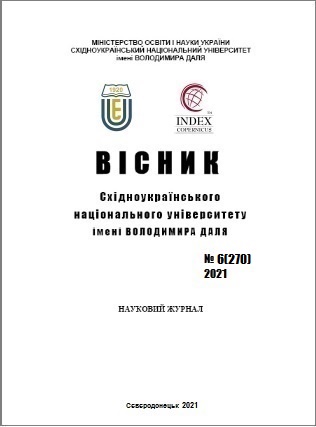Identification of dynamic characteristics of control objects
DOI:
https://doi.org/10.33216/1998-7927-2021-270-6-129-134Keywords:
mathematical model, dynamic characteristics, ammonia production, identification, acceleration curve, control object, transient processAbstract
The article proposes a method for obtaining a mathematical model of the control object, in which the transient process of the control object is selected as the initial data. The advantages of this approach are as follows: it is based on objective data that form the control object itself; the implementation of this approach is quite simple; obtaining an adequate and accurate mathematical model, since global information about the dynamic characteristics of the control object is used to obtain it.
This study is carried out to optimize the considered technological process.
As a result of the research, it has been established that if, when deriving a mathematical model, we restrict ourselves to the degree of the differential equation (the degree of the transfer function) and take it equal to two, then the development of a mathematical model is greatly simplified. In some cases, it is possible to reduce a high-order model to a lower-order model, sometimes even of the first or second order, and at the same time not significantly lose in the accuracy of assessing its characteristics, that is, any physical system can always be described by a relatively low-order model, neglecting some of its characteristics. ... This is possible due to the following factors: the problem of analysis and synthesis is much easier to solve for low-order models; the accuracy of calculations on a computer is inversely proportional to the magnitude of the order of the model; if the model is of the first or second order, we have the information necessary for analysis and synthesis; Despite the fact that the high-order models themselves have never been completely accurate, in some cases, reducing their order can give results that are not inferior in the accuracy of the high-order model. Often times, increasing the order of a model does not improve its accuracy.
The identification error obtained as a result of calculations is acceptable for calculations of this type.
When solving the problem in the article, the following questions are solved: the number of points on the acceleration curve of the control object, which must be selected; which identification algorithm to choose; way of placing points on the acceleration curve of the control object; the influence of the number and location of points on the approximation error.
The proposed method for obtaining a mathematical model allows, by regulating the input values, to obtain optimal initial parameters in particular and to increase the efficiency of the technological process as a whole.
References
1. Артеменко А. И. Органическая химия / А. И. Артеменко – М. : «Высшая школа». – 1987. – 430 с.
2. Амиак: обзор технологий. [Электронный ресурс]. – Режим
3. Стенцель Й.І. Автоматизація технологічних процесів хімічних виробництв: Підручник [Текст] / Й.І. Стенцель, О.В. Поркуян - Луганськ: вид-во Східноукр. нац. ун-ту ім. В. Даля, 2010. – 300 с.
4. Математичне моделювання технологічних об’єктів [Текст] : Підручник / О.Б.Целіщев, П.Й.Єлісєєв, М.Г.Лорія, І.І.Захаров – Луганськ. Вид–во Східноукр. нац. унів. ім. В. Даля, 2011. – 421 с.
5. Принципы математического моделирования химико-технологических систем [Текст] / В.В.Кафаров, В.Л.Перов, В.П.Мешалкин и др.– М.: Химия, 1974. - 344 с.
6. Driankov, D. Palm R. Advances in Fuzzy Control [Text] / D.Driankov, R.Palm // Physica-Verlag. Heidelberg. Germany - 1988. P. 129-137.
7. Pedrycz, W. An Introduction to Fuzzy Sets: Analysis and Design. [Text] / W.Pedrycz, F.Gomide // MIT Press. Hardcover. - 1998. №2. – Р. 24-41.
8. Seraya O.V., Demin D.A. Linear regression analysis of a small sample of fuzzy input data (2012) Journal of Automation and Information Sciences, 44 (7), pp. 34-48.
9. Методы классической и современной теории автоматического управления: Учебник в 5-й т. / Под ред. К. А. Пупкова, Н. Д. Егупова. – 2-е изд., перераб. и доп. – М.: Издательство МГТУ им. Н.Э. Баумана, 2004. – Т.1: Математические модели, динамические характеристики и анализ систем автоматического управления. –2004 – 656 с., ил.
10. Математичне моделювання технологічних об’єктів: Підручник. / О. Б. Целіщев, П. Й. Єлісєєв, М. Г. Лорія, І. І. Захаров – Луганск: Вид-во Східноукр. нац.ун-ту. – 2011. – 421 с.
11. Черноруцкий И. Г. Методы оптимизации в теории управления: учебное пособие / И. Г. Черноруцкий. — СПб.: Питер, 2004. — 256 с: ил.
12. Патент України на корисну модель 77800. МПК (2012.01) G05D 19/00. Спосіб знаходження оптимальних настроювань регуляторів / Ананьєв М.В., Целіщев О. Б., Лорія М.Г., Єлісєєв П.Й., Павленко Ю.В.; заявл. 03.09.2012; опубл. 25.02.2013. Бюл. №4.
13. В.А. Иванов и др. Математические основы теории автоматического регулирования, М.: «Высшая школа», 1971 г., 797 с.
14. Теория автоматического управления: Учеб. Для вузов по спец. «Автоматика и телемеханика». В 2-х ч. Ч.1. Теория линейных систем автоматического управления / Н. А. Бабаков, А. А. Воронов, А. А. Воронова и др.; Под ред. А. А. Воронова. – 2-е изд., перераб. и доп. – М.: Высш. шк., 1986. – 367 с.
15. Волков Е.А., Численные методы – М: Наука, 1987. – 248 с.
16. Математическое моделирование основных процессов химических производств. Учеб. пособие для вузов. / В.В. Кафаров, М.Б. Глебов. – М.: Высш.шк., 1991.–399с.
17. Математическое моделирование химико-технологических систем: Учеб. пособие в 3ч./ под ред Л.С. Гордеева. – М.:РХТУ, 1999– 48с.(ч1); 47с.(ч2), 67с.(ч3).
18. Технологічний регламент виробництва аміаку.
19. Т.А. П’явченко. Проектування АСУ ТП в Scada-Системі. Навчальний посібник. м. Таганрог. 2007.-84 с.
20. Дьяконов В. П., Круглов В. В. MATLAB. Анализ, идентификация и моделирование систем. Специальный справочник. – СПб.: «Питер», 2002. – 608с.
21. Эдвардс Ч.Г., Пенни Д.Э. Дифференциальные уравнения и проблема собственных значений: моделирование и вычисление с помощью Mathematica, Maple и MATLAB = Differential Equations and Boundary Value Problems: Computing and Modeling. – 3-е изд. – М.: «Вильямс», 2007 с.

